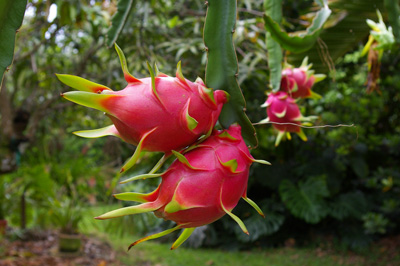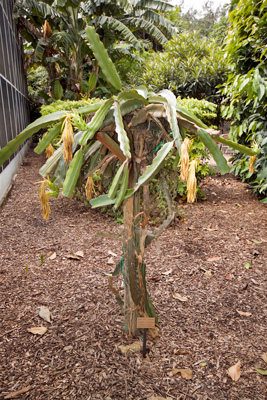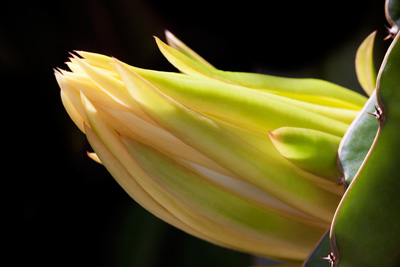Dragon fruit: The name alone is mysterious and intriguing, and its appearance does not disappoint. The fruit itself looks like it’s straight out of a video game. It has a flame-red, egg-shaped body and what looks like reptile scales tipped in yellow-green. The fruit may look like exotic, but you can grow it in a typical South Florida garden.
While you may not initially equate “cactus” with “edible,” the dragon fruit, also known as pitaya, is indeed borne on a cactus. When the fruit is cut open, the flesh is revealed to be snow-white and peppered with tiny, edible black seeds throughout — quite a contrast to the exterior.
The flesh is mildly sweet, some say comparable to a melon. A source of calcium, fiber and vitamin C, the dragon fruit is widely cultivated throughout much of the tropics, particularly in Asia. Its popularity in tropical Asia combined with the dragon reference may lead us to believe it originated in Asia, but the fact is no one seems to agree on where it came from. We do however know it is in the cactus family (Cactaceae), and therefore almost sure to be of New World origin.

Dragon fruit.
This vine-like cactus likes to climb, and is considered a semi-epiphyte, so providing some means of support is essential if you grow it. Here at Fairchild, it grows up an approximately six-foot-tall T-shaped wooden support.

The sprawling dragon fruit cactus requires support during its growth. Kenneth Setzer/FTBG.
Propagation from seed is certainly an option, but you’ll have to wait a few years for fruit. Growing it from a stem cutting is a better strategy.
If you acquire a fresh cutting, it’s best to place it in a shady location for a week or more to allow the cut end to dry and “heal” to avoid fungal infections before placing it into soil.
Thereafter, a good, well-drained potting mix will serve to encourage roots to grow. Mine are in a pot for now to ensure proper drainage and so I can keep a better eye on potential problems. When new growth appears, it will be safe to plant them in the ground in a sunny location.
Cuttings can take four months or more to develop really strong root systems. As the stems grow, make sure you keep them directed towards their intended support or trellis.
Remove lateral growth until the stems reach at least a few feet up their support. Then you can prune the tips of the stems to induce multiple branching, and eventually, fruiting. This cactus develops some pretty thick and heavy stems, so your support will need to ultimately hold quite a bit of weight. Use twine or bands of fabric to help attach it to the support, avoiding wires that can cut into the weighty stems. Eventually the stems will grow aerial roots to grip onto the support.
Keeping soil well drained can be a challenge during the rainy season, but one way to help maximize drainage is by planting the dragon fruit in a raised mound. Dig a hole and mix whatever native soil you excavate along with manure and compost to form the mound at least a foot high. The additions will also help feed your new planting. Add a layer of mulch, which will add to the nutrition of your soil and its microorganisms as it decomposes, but keep mulch away from the base of the plant to avoid introducing fungi and rot.
The dragon fruit grown in Fairchild’s Edible Garden is Hylocereus undatus “Vietnamese giant.” This variety can self-pollinate, which means it can produce fruit on its own without help from you. Be aware that other varieties may require cross pollination with another plant. That’s not a bad thing, but you’ll need to make sure other plants of the same variety are nearby, and either supply the natural pollinator (probably moths, since the flowers open at night) or learn how to pollinate yourself (wearing a moth costume helps).
Dragon fruit flowers are also a treat, edible when in the bud stage as a cooked vegetable, otherwise opening into a huge white flower that to me smells like peanuts.

Dragon fruit flowers are both beautiful and edible. Kenneth Setzer/FTBG.
Flowering is triggered by heavy rains and warm weather, plentiful during summer in the southeast. They’ll do fine during South Florida winters too, requiring a drink only during very extended dry periods. Fruit ripen four to five weeks after flowering, which continues during summer and into early fall. You can harvest the fruit when it’s an intense, fiery red.
